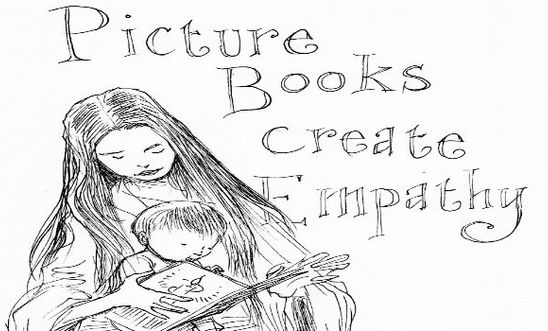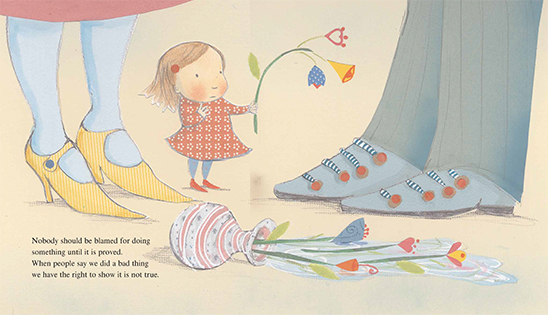
Children’s picture books and human rights

By Nicky Parker, Publisher, Amnesty International UK
Why picture books for young children are the perfect place to celebrate human rights
We work on life and death matters all over the world. People know us for our campaigning and lobbying on human rights issues like torture, the death penalty and refugee rights. The name Amnesty is indelibly associated with dark matters.
So it’s not surprising when people question our interest in picture books for young children. Some say that it’s not appropriate for children to know about human rights. Others that fictional worlds are not in our remit.
But human rights are utterly positive and belong to all of us from birth. It’s their violation that causes the dark and dangerous to happen. If young children are supported to understand and celebrate concepts of truth, fairness and freedom, they are better equipped to recognise and challenge discrimination.
‘Beyond personal contact, nothing brings us closer to our fellow human beings than fiction.’ Bali Rai, author
Fictional worlds have real power to inspire change – the targeting of writers and artists by dictatorial regimes is testament to that. But it doesn’t have to be hardcore. Picture book writers and illustrators are expert at navigating a safe course through difficult places. They know what is appropriate for children at different stages. They can make abstract rights real in a way that makes sense for little ones – and the best artists make it fun and do it without moralising. There can hardly be a better medium than picture books to celebrate and illuminate the positive values of human rights.
Just look at Polly Dunbar’s brilliant interpretation of our right to be presumed innocent until proven guilty in our book We Are All Born Free. I have seen a two-year-old in her high chair cackle with laughter at this. It’s wholly appropriate for little ones, even though it addresses deep issues of justice, innocence and guilt. And it isn’t remotely patronising.

© Polly Dunbar, Article 11 (Amnesty International/Frances Lincoln Children's Books
What are human rights values anyway?
Human rights law is rooted in the Universal Declaration of Human Rights (UDHR), a milestone document that was created in the wake of the horrors of World War Two. Drafters and signatories came from multiple faith and cultural backgrounds, and from all regions of the world. Finding meaningful common ground must have seemed nearly unachievable. Yet they did it.
They succeeded because they identified 30 rights that are rooted in shared values such as truth, equality, justice, fairness and freedom. Without these, there can be no trust. Without trust, societies cannot flourish.
And because these values are shared across countries, cultures and faiths, we can find them in children’s books from early years on, all over the world. Stories like the first Amnesty CILIP Honour winner There’s a Bear on My Chair explore human rights values with a light touch and make them fun.
‘A person’s a person, no matter how small.’ Dr Seuss, in Horton Hears a Who
Out of the UDHR came the Convention on the Rights of the Child (CRC) in 1989, which addresses the previous marginalisation of children. It’s based on four key principles:
- Non-discrimination
- The best interests of the child
- The inherent right to life, survival and development
- Children’s right to participate in decisions that affect their lives (this one is particularly ground-breaking)
In other words, the CRC gives children a voice. It also explicitly requires its state signatories to educate everyone about children’s rights, which arguably doesn’t happen in the UK. It’s one reason we at Amnesty are so interested in the power of children’s fiction.
‘Ubuntu: A person is a person because of other people.’ Archbishop Desmond Tutu, in the foreword to Freedom
When a child is immersed in a story, they’re not just gaining knowledge but also empathy – that remarkable skill that helps us imagine what it might feel like to be someone else, even if that someone is a mouse deprived of its chair. All good picture books build the empathy muscle. With empathy comes caring and respect.
But it’s not just about empathy. Reflecting on stories and, ideally, discussing them with an adult, helps young readers to think not just about how they would feel but what they might do in that situation. With knowledge and understanding, children learn they have rights too, right now, no matter how small they are. They become more confident to speak up. Fiction upholds their right to have a voice.
Picture books are a bedrock of happiness, fulfilment and children’s rights. The best of them celebrate our precious freedoms and give young people deep inner strength for life.
Our blogs are written by Amnesty International staff, volunteers and other interested individuals, to encourage debate around human rights issues. They do not necessarily represent the views of Amnesty International.
0 comments